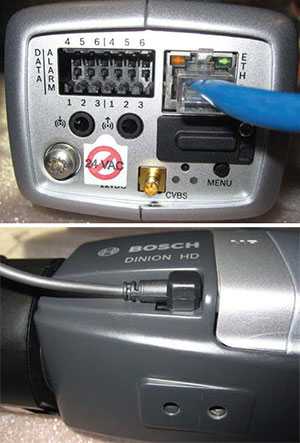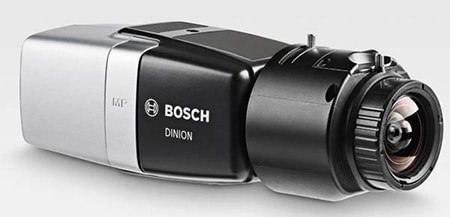The Dinion IP starlight 8000 MP network camera from Bosch Security Systems is the top of the line in its series of box cameras and, at 5 megapixels (MP), has the highest resolution within the product line. There are 10 models in the line, ranging from the traditional box camera design to outdoor “bullet”-style camera assemblies to a compact assembly that can be discreetly mounted as needed. The 8000 MP I received was shipped with a Bosch LVF-5005C HD lens for my testing. It is designed for MP camera use and has a focal range of 4.1-9mm. The lens is also IR corrected to provide optimal viewing when the camera assembly switches from color to black-and-white in low light conditions.
Construction
The 8000 MP is one of a handful of IP-based box cameras I have dealt with and I was certainly surprised at its heft when I removed it from the box. The assembly is very heavy when compared to analog units, weighing in at almost 2 pounds without a lens attached, or roughly twice the weight of other units I have worked with. Its bulk can be attributed to its sturdy aluminum shell construction and all of the camera’s electronics that are packed inside the case. As with most box cameras, the unit’s housing has a 1/4-inch 20 threaded socket on the top and bottom of the assembly to allow it to be secured on a pendant mount or inside an enclosed camera housing. The 8000 MP is constructed with a standard CS mount to accept the installation of a lens of your choosing (a C mount lens with adapter can also be used). The camera also has a standard four-pin connector located on the camera’s lower section to allow the use of DC-iris lenses.
The camera is designed to be powered via PoE through the RJ45 connector, or it can also be powered via 12VDC through a phoenix connector on the rear of the housing. I was surprised the 8000 MP only accepts a 12VDC power source considering the majority of box camera housings require 24VAC power for the heater and blower assemblies. Alluding to this issue is a very prominent sticker covering the phoenix socket on the rear of the housing advising the installer not to use 24VAC. As the 8000 MP is an ideal camera to be used as a replacement model for existing analog installations utilizing a coax/Ethernet adapter, the ability for dual voltage should have been a “no-brainer” for the designers as it certainly would have simplified installation in a lot of situations.
The camera is also equipped with a composite video output on the back of the housing, which allows the installing technician to attach an analog monitor and perform initial setup and alignment. The connection to the camera is made with a special cable from Bosch consisting of a male BNC connector on one end and a female SMB connector on the other end. Again, I have to wonder what the designers were thinking when they designed the analog video output. I have a handheld monitor that I use for projects and I have about four different connectors I carry with me that have always allowed me to connect to analog and IP cameras alike. The last time I saw and used an SMB connector was many years ago on a wired antenna connection for a body mic. Surely, the chassis space assigned for this could have accepted a sub-mini (2.5mm) phone jack as easily as the SMB connector.
During my evaluation, I noticed the socket for the DC-iris lens connector has a positive/negative aspect going for it. The positive aspect is when a DC-iris cable is plugged in the connection is recessed and out of the way on the side of the camera housing. The negative aspect is the connector can be a bit of a pain when it comes to removing the camera lens cable. Because the socket is mounted in a recessed location you must use a small screwdriver to pry the plug from the socket. Your only other option is to grab the cable and tug on the plug to dislodge it — not something I recommend on a cable that has four tiny wires inside it! While the recessed mount is nice for the camera’s aesthetics I really don’t think a plug that size protruding from the camera’s side makes much difference.

The 8000 MP camera can be powered via PoE through an RJ45 connector, or via 12VDC through a phoenix connector on the rear of the housing. Its composite video output allows attaching an analog monitor to perform initial setup and alignment.
Features
The 8000 MP has a suite of options and features for the end user to use with their DVMS system. For starters the camera has two H.264 video streams providing the primary video sources for the CCTV system, and both of the streams are configurable to allow the end user to customize the bandwidth usage on the system. There is also an MJPEG video stream for lower resolution monitoring if desired. Combine this with the ability to select preprogrammed user modes for a variety of environments including indoor, outdoor, and sports and gaming, just to name a few, and the camera is ready to go with just a few menu selections. The 8000 MP’s literature touts its low light performance (as most manufacturers do) along with the camera’s auto exposure and dynamic noise reduction capabilities. These are areas where I am always cautiously optimistic that the camera can live up to the hype from the manufacturer. I have to admit I was impressed with the camera’s signal processing and video images provided in difficult lighting situations, and will cover this in detail in the next section.
In addition to the operational functions you would expect to find in a high-end IP camera, the 8000 MP has several advanced features built into the camera itself that are usually offered through the DVMS to which the camera is connected. The 8000 MP has video content analysis that allows the camera to be set up for motion alarms as well as directional-based analysis of particular scenes. This can be very beneficial where pedestrian traffic must be monitored for persons entering or leaving a specific location such as an airport entry or exit. The 8000 MP can alert if there is someone proceeding against the established flow of pedestrians and issue an alert to notify the system operator. The camera can also detect the speed of an individual to differentiate between someone walking through an area versus someone running to avoid detection. The 8000 MP can also be programmed to perform such tasks as alarm on tampering, object removed/left behind and people counting to name a few.
The 8000 MP also has a MicroSD card slot on the rear of the housing to allow local recording of video incidents in the camera itself. The literature states the camera is capable of storing up to 2TB of data in the extra memory slot. This is optimistic on the part of the manufacturer, as the highest capacity MicroSD card available is 128GB, which means that capacities higher than that are theoretical and have not been tested.
Setup
Bosch doesn’t require specialized software to access the 8000 MP for system programming and I thank it for this. I connected the 8000 MP to my PoE switch, allowed the unit to get an IP address assigned via DHCP, scanned for the unit with my network software and found it with ease. I was able to directly access the camera through my Web browser after accepting the ActiveX applications (which almost every camera I test requires). I didn’t have to know a user name or password (another plus) to gain entry to the system menus and was able to peruse the camera’s options.
The camera menu has two sections for programming, Basic and Advanced. The Basic section is just that, nothing fancy and the options will get you going for a regular installation. The Advanced settings menu, well, you might want to bring a sack lunch when you start on this side. There are eight programming sections under the Advanced tab and these are for the General, Web Interface, Camera, Recording, Alarm, Interfaces, Network and Services options. Each selection in the programming menus varies from easy to understand, basic programming (time and date, naming parameters) to some very complex options. Thank goodness Bosch provides a “help on this page?” option on every menu selection. While quite esoteric in content and tone, this was still useful as I made my way through the menu selections and played with the programming options. As cameras become more complicated and more options and feature sets are included, I do hope the manufacturers take the time to include this kind of help menu. It can be a real pain to have to flip between a manual, an online help page and the camera itself when it comes to in-depth camera programming.
Testing
Once I had the 8000 MP programmed with the necessary network settings, I began to check the camera’s imaging with different fields of view and lighting conditions. The images produced by the 8000 MP were crisp and sharp, and the field of view offered by the 4-9mm lens provided me with a sufficiently wide viewing angle. The camera can perform electronic back focusing, something that is very helpful when you want to finetune the image. The camera does sound a bit like a coffee grinder when it makes this adjustment, but the results are great.
After I tried several different lens settings and checked the video quality, I decided to try other lighting conditions. First, I simulated the camera covering a doorway with extreme backlighting issues. I viewed a video image that provided excellent detail with the subject in the doorway and I could view details on his face that I normally wouldn’t be able to see. The camera also responded to quickly changing lighting conditions as I moved it from the window to the interior of the room.
Later in the evening, I moved the camera outside to test the low light capability of the 8000 MP. In a rural area where there aren’t any streetlights, on a lot with very little lighting, I placed the 8000 MP on a deck and focused the camera toward the woods. The images I got back were far above my expectations. I could see excellent details of the trees and other objects in the lot where, for all intents and purposes, it was pitch black to my eyes.
Conclusions
I consider the 8000 MP more of a specialized camera than an everyday model. My reasoning is a) the camera requires an enclosure for security; b) the camera’s directional view can be easily detected by the bad guys; and c) the camera’s versatility is limited in my opinion. I really don’t like it when the bad guys can see which direction a camera is pointing; this is why I am a big fan of fixed domes when a location requires a fixed camera. I also realize there are locations where you need a camera with a larger lens than a regular fixed dome can provide. For these locations the 8000 MP is a perfect option. The 8000 MP can also be used in indoor locations if aesthetics aren’t an issue and the security department doesn’t care if everyone knows which way the camera is looking.
Verdict
- Features 1 2 3 4 5
- Construction 1 2 3 4 5
- Setup 1 2 3 4 5
- Performance 1 2 3 4 5
- Overall 1 2 3 4 5
First published in the October 2014 issue of Security Sales & Integration magazine.




